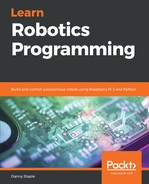I've laid out some of the different kinds of motors, all of which are used in robotics. Let's take a look at what each one does, and how we might use them for different kinds of motion, as shown in the following photo:

I've shown some common motor types in the preceding photo. Let's understand them in detail:
- The most common type of motor is the DC motor. This has the property of spinning in proportion to the amount of voltage running through it.
- A bare DC motor like this tends to spin a little too fast to be useful bare, and is very easily stopped. This is a DC Gear motor—a DC motor fitted with a gearbox, providing a reduction in speed and increase in mechanical advantage so it can move a larger load. Note that this gear motor is missing soldered leads! These types are most useful in the wheels of a robot. We will be attaching gear motors very much like the second image to our robot in chapter 6, Building Robot Basics - Wheels, Power, and Wiring and chapter 7, Drive and Turn - Moving Motors with Python.
- This is the servo motor (or servomechanism). A controller sends a signal to this type of motor telling it what angular position to move to, with code working in degrees. The motor will attempt to reach and hold that position using it's own internal feedback loop, which means it can repeatably reach the same position. Servo motors are used in pan and tilt mechanisms to position sensors, robot arms, or other limbs and appendages, where the ease of positioning makes them more suitable than other motor types. We will be programming servo motors in Chapter 10, Using Python to Control Servo Motors.
- This is a stepper motor. These have coils powered in a sequence to allow the motor to step a certain number of degrees, so it can be used for very precise motions. Stepper motors tend to be slower and generate a lot of heat compared with DC motors or servo motors, but are most suitable for fine control, like that needed in 3D printers and high-end robot arms. They are also more expensive than the other types.
Linear actuators are devices where electrical signals are converted into motion along a single axis. These can be a stepper motor driving a screw in a fixed enclosure or magnetic systems that work like mag-lev trains and move very smoothly. Refer to the following photo:

A solenoid is a simple linear actuator using an electromagnetic coil with a metal core that is pulled or pushed away when power is applied to it. A common use of this type is in a doorbell mechanism. They are also used to operate valves on hydraulic or pneumatic actuators, which can create powerful motions like those seen in excavators and large industrial robotic arms.
